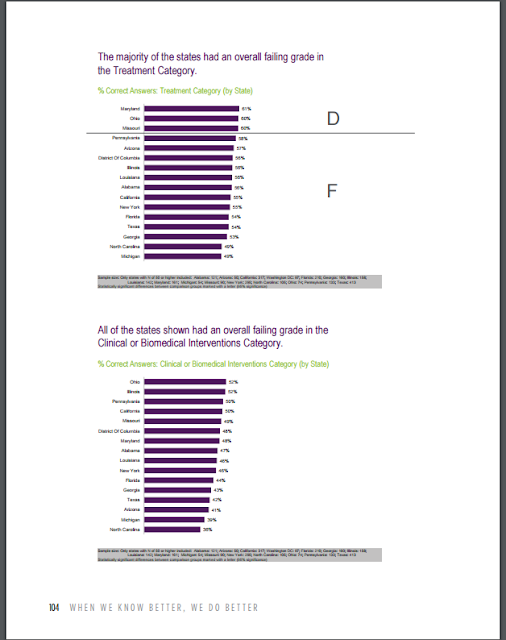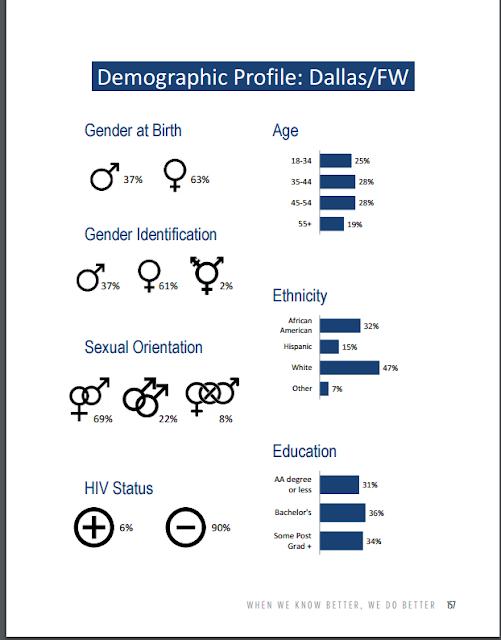"When We Know Better, We Do Better: The State of HIV/AIDS Science and Treatment Literacy in the HIV/AIDS Workforce," presents results from the U.S. HIV Workforce Knowledge, Attitudes, and Beliefs (KAB) Survey, the largest survey ever conducted of non-medical personnel working in HIV/AIDS in the United States. (The link goes live on Friday, February 6, 2015 at 12:01 a.m.) On Friday, the Institute will launch the #KnowBetterDoBetter Tour, a series of town hall meetings to help the public and media understand survey results for 10 major American cities.
Overall, HIV/AIDS health care service providers at health departments and AIDS-service and community based organizations answered only 63 percent of questions correctly—essentially earning a D grade in their knowledge of HIV science and treatment.
Participants were more likely to answer questions about basic science correctly, scoring a 76, or a C. But the average score on treatment-related questions was a 56, or an F.
Participants were more likely to answer questions about basic science correctly, scoring a 76, or a C. But the average score on treatment-related questions was a 56, or an F.
Respondents appear particularly ill-prepared to assist HIV-negative people in using antiretroviral-based biomedical prevention tools, such as pre-exposure prophylaxis (PrEP), or to help HIV-positive people in understanding treatment as prevention—tools essential to ending the HIV/AIDS epidemic. Participants answered 46 percent of biomedical questions accurately, an F.
Given the goal of achieving an AIDS-free generation, participants' lack of knowledge is shocking.
Given the goal of achieving an AIDS-free generation, participants' lack of knowledge is shocking.
"All the tools in the world will not end HIV/AIDS unless those responsible
for using these tools understand them, believe in them, and know how to use them," says Phill Wilson, President and CEO of the Black AIDS Institute..." CONTINUE READING
The report was scathing and had very valid points, but what stuck out to me the most is one of the findings:
Race Matters:
Highest Risk, Lowest HIV
Science and Treatment
Knowledge Among Communities of Color
- "Black and Latino people account for
14% and 16% of the U.S. population,
respectively, but they make up 44%
and 21% of new HIV infections.3
With Black and Latino communities
facing disproportionate risks for
HIV infection, they need biomedical
treatment and prevention technologies
the most. By extension, they need an
HIV workforce that is fully prepared
to seize new opportunities to lay the
foundation to end the epidemic.
However, Black and Latino workers
in the AIDS field were significantly
less likely than white respondents or
those from other races/ethnicities
to exhibit robust HIV science and
treatment knowledge. Importantly,
these differences remained statistically
significant after controlling for
education, region of residence, time
working in the AIDS field, or any other
variable taken into account in the
survey. On average, Black respondents
scored about six points lower than
white survey participants, while Latino
workers scored eight points lower.
By contrast, LGBT and HIV positive
survey participants scored
about three points higher than other
survey participants. Unlike Black and
Latino communities, where treatment
education programs have traditionally
been weak or non-existent, LGBT
staff belong to a community that
has prioritized grassroots treatment
education since the epidemic’s
early years. People living with HIV
obviously have a personal interest in
learning about HIV-related science and
treatment issues. In addition, a host of
resources (e.g., magazines, websites,
blogs) are available for people living
with HIV to learn about treatment
issues, but these have not always been
targeted to Blacks and Latinos living
with HIV.
Other demographic patterns
emerge from the findings. The
mean score for male respondents is
significantly higher than for women,
although women who participated
in the survey were more likely than
their male counterparts to score in the
top quartile. Women were also more
likely than men to score in the bottom
quartile.
As a general rule, age did not
directly correlate with HIV knowledge.
However, the youngest respondents
(ages 18-24) scored by far the lowest of
all age groups."
Here are some parts of the report that you should take note of, these screengrabs are centrally focused on the state of Texas.
Houston
Dallas - Fort Worth
Austin
For the full report: https://www.blackaids.org/images/reports/15-know.pdf




















No comments:
Post a Comment
Note: Only a member of this blog may post a comment.